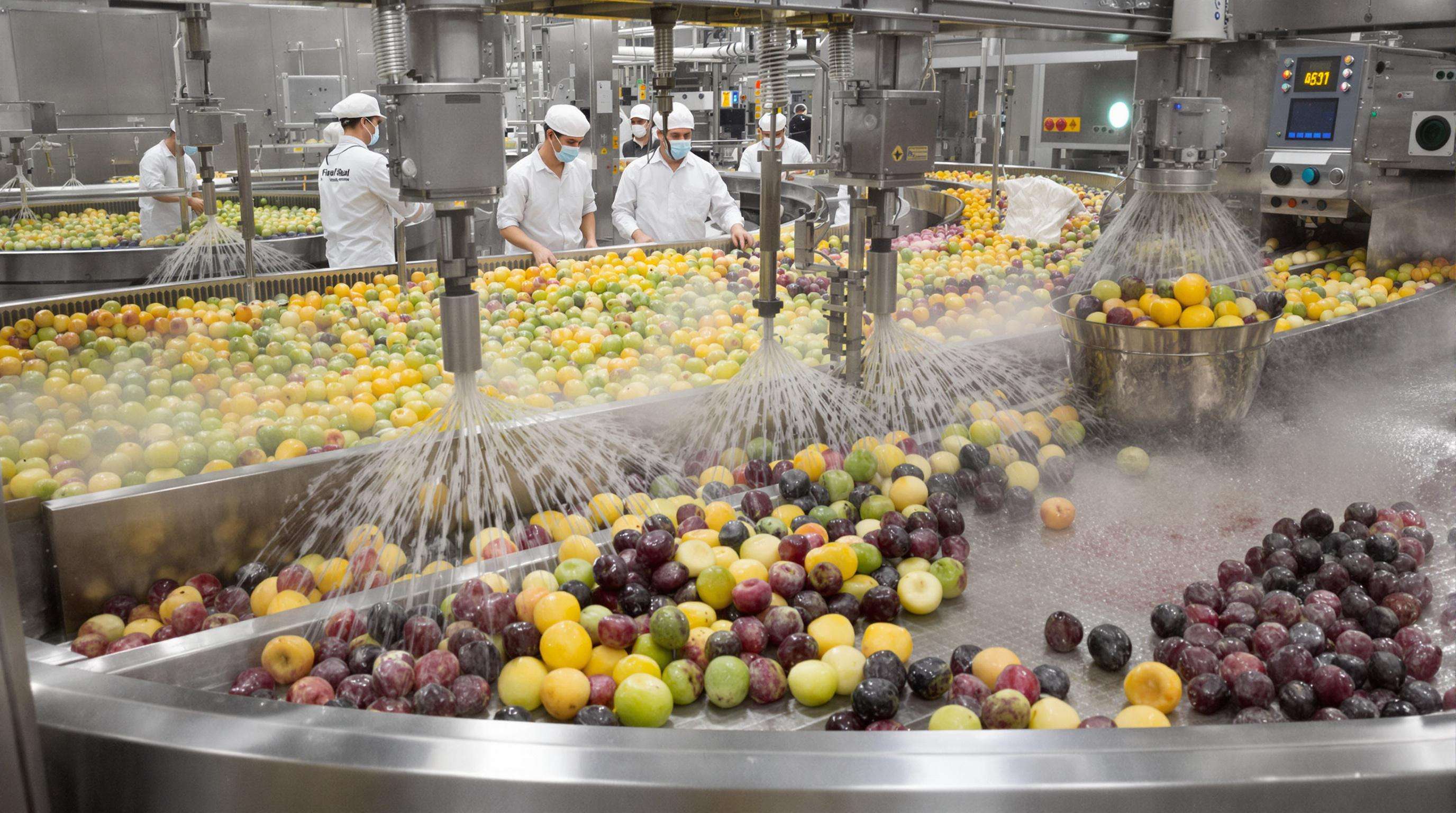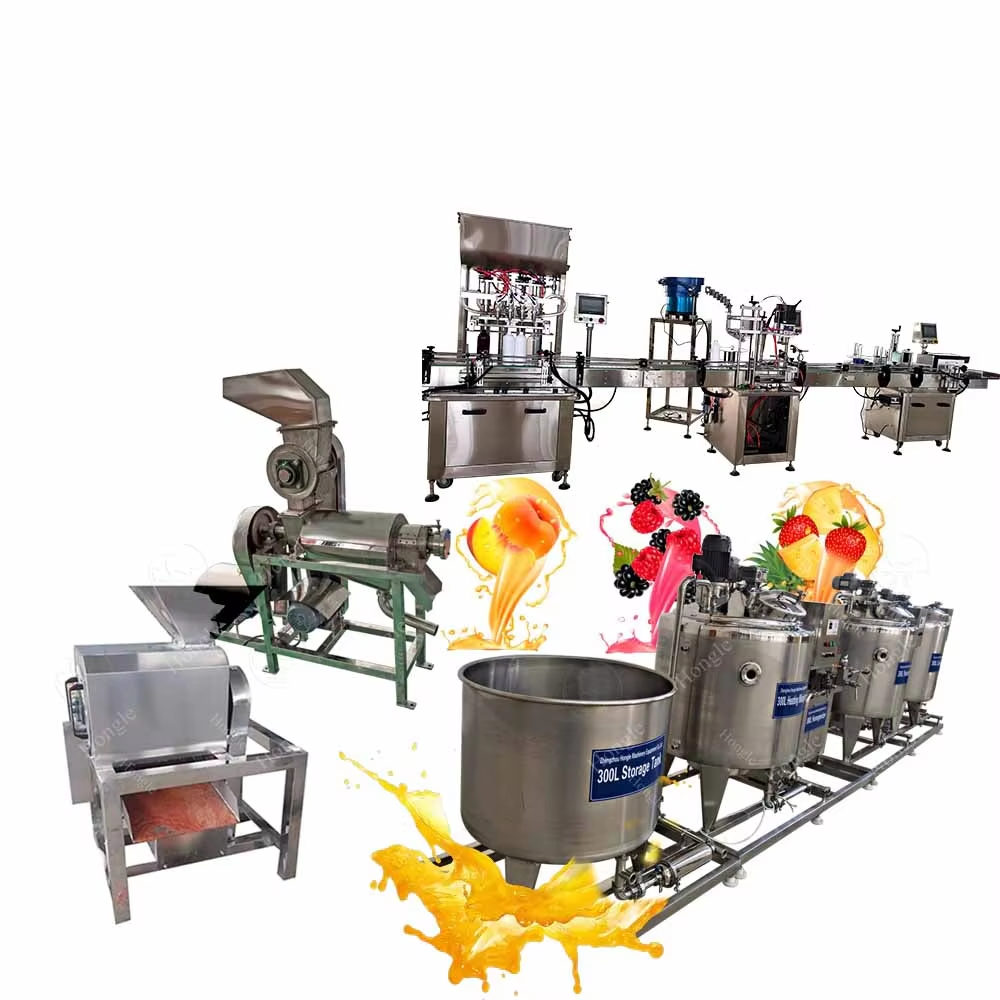Xammalın işlənməsi Şirə istehsal xətti

Əvvəlki meyvə qəbulu şirə istehsalının keyfiyyət kubudur. Aşağı keyfiyyətli komponentlər dadı, qida dəyərini və saxlama müddətini pozur. Ən müasir zavodlar partlayışların çirklənməsini qarşısını almaq və məhsuldarlığı artırmaq üçün çeşidləmə, təmizləmə və ferment istehsalı sahəsində ciddi tədbirlərə əsaslanır. Sənaye məlumatları göstərir ki, şirə istehsalında mikrobioloji çağırışların 40% səbəbi kifayət qədər emal olunmamasıdır, bu da düzgün emalın əhəmiyyətini göstərir.
Keyfiyyətli şirə almaq üçün meyvələrin çeşidlənməsi və seçilməsi
Optik sorterskalar meyvələri 10+ tonn/saat sürətində nöqsanlar, yetişkənlik və ölçülərinə görə yoxlayır və keyfiyyətsiz məhsulların 25%-ni kənarlaşdırır. Çoxspektral görüntüləmə insan inspektoru üçün görünməz olan daxili çürütməni müəyyən edə bilər. Duzgün şəkər/turşu balansını saxlamaq üçün müntəzəm olaraq müvafiq meyvələrin toplanması vacibdir. Məsələn, yetim sitruslar acıqlıq verir, çox yetişmiş manqolar isə fermentasiyanı sürətləndirir.
İrəliləmiş Yuyucu və Təmizləyici Texnikalar
Tərs axın kanal sistemləri, yüksək sürətli təzyiqlə su ilə çilənən məhsulu qarışdırmaq üçün su ilə doldurulmuş rezervuarlar istifadə edərək səthdəki pestisidlərin 99.7%-ni aradan qaldırır (Qida Təhlükəsizliyi Jurnalı, 2023). Ozonlaşdırılmış su və ultrason təsiri diş əti səviyyəsinin altında anaerob bakteriyaların böyüməsini qadağan edərkən sağlam və ağrısız aerob bakteriyaları saxlayır.
Ferment aktivləşdirilməsi üçün ön emal
15-20 dəqiqə 50-55°C temperaturda nəzarətli qızdırma endogen pektin metil esterazın aktivləşməsinə səbəb olur və şirə çıxımını 18% artırır. Meyvə növlərinə uyğunlaşdırılmış ferment vannaları parçalanmanı sürətləndirir:
- Sitruslar: Segmentlərin ayrılması üçün pektinaza infuziyası
- Ərikməyən meyvələr: Toxumların partlatılması üçün sellulyaza müalicəsi
-
Alma: Nişastanın çevrilməsi üçün amilaza təsiri
Bu mərhələ sonrakı presləmə üçün pulpun vizkostini tənzimləyir, oksidləşməni və bulanıqlığın əmələ gəlməsini qarşısını alır.
Tehnoloji sırada şirə çıxarma üsulları
Özümə və püre alma üsullarının müqayisəsi
Mexaniki qazıyıcılar və val rollər müasir şirə çıxarma sistemlərinin əsasını təşkil edir. Plastırlar meyvə hüceyrələrini yüksək sürətli bıçaqlarla (dəqiqədə 80,000 nəf.) parçalayır, şirənin çıxarılma nisbəti 85-90% olur, lakin şirənin temperaturu artır və havanın şirədə həll olunması nəticəsində oksidləşməyə daha çox məruz qalır, bu da şirənin saxlama müddətinin qısa olması deməkdir. Əks istiqamətdə dövr edən silindrlərlə təchiz edilmiş val rollər məhsulu daha yumşaq şəkildə ezir və uçucu aromatların 15-20% artıq saxlanması müşahidə olunur (2023-cü il məlumatlarına əsasən, Food Engineering Jurnalından). Val sistemləri 30% daha yavaş işləmə sürətinə malikdir, lakin premium şirə brendi üçün yüksək keyfiyyətli məhsul aşağı istehsal gücüni kompensasiya edə bilər.
Verimin optimallaşdırılması üçün fermentlərlə işləmə
Sonuncu vasitə kimi pektinaza və sellulyaz fermentləri meyvə hüceyrə divarlarını seçici şəkildə həzm edərək bağlı mayeləri azad edir. Kənd Təsərrüfatı İnstitutunun meyvə emalı üzrə tövsiyələri ferment aktivliyini maksimuma çatdırmaq üçün 45-50°C temperatur və 4,5-5,5 pH istifadə edilməsini məsləhət görür, bu isə yalnız mexaniki ekstraksiyaya nisbətən 18-22% artıq verir. Vaxta görə tənzimlənmiş tətbiq (60-90 dəqiqə) çox ekstraksiyanı qarşısını alır, bu isə acıqla müşayiət olunur, miqdar və sensor qavrayış arasında düzgün balans yaradır.
Soyuq Press vs. Termal Ekstraksiya Səmərəliliyi
50°C-dən aşağı temperaturlarda işləyən soyuq pres sistemləri Vitamin C kimi istiliyə həssas vitaminlərin 95%-ni saxlayır, lakin çıxım 60-70%-ə qədər azalır. 80-85°C temperaturda işləyən termal vint preslər 80-85% çıxım verir, lakin qida mühəndisliyi jurnalı 2023-cü il məlumatına görə, qida maddələrinin 30-40% -i deqradasiyaya uğrayır və temperaturun 85-95°C aralığında daha yüksək deqradasiya müşahidə olunur. Amosu və Aremu (2009) -a görə isə yağlılıq faizi 10 və 20% olan nümunələrdən müvafiq olaraq 91% və 90,5% çıxım itkisi ilə alınır. Tədricən inkişaf edən istehsalçıların çoxu kombinəedilmiş metoddan istifadə edəcək - yüksək həcmli istehsal üçün termal ekstraksiya və premium qida maddələrini saxlayan məhsullar üçün soyuq pres xətləri.
Şirə istehsalında presləmə və ayırma mərhələləri
Filtrasiya sistemləri ilə aydınlaşdırma
Ən müasir meyvə şirəsi istehsal xətləri şirənin həm içmək, həm də görünüş baxımından mükəmməl şəffaf qalmasını təmin etmək və qida keyfiyyətini qorumaq üçün çoxmərhələli süzgəc sistemləri ilə təchiz edilmişdir. Keramik və ya polimer elementlərlə fabrikdirək membran süzgəc. Partikulların çıxarılması üçün 0,1 mikrona qədər. Bu dəqiqlik rəngin və dadın saxlanılması üçün fermentativ qaralmanı maneə törədir. PLC-ə qoşulmuş buludluq sensorları təmiz süzgəc təkrar yuyulma dövrlərini tənzimləyərək buludluqdan azad istehsal seriyasını təmin edir.
Sentrifüj Ayrılma Texnologiyası Tətbiqləri
Şirəni ekstraksiya edərkən mərkəzdənqaçma qüvvəsi ilə işləyən yüksək sürətli ayırıcılar istifadə olunur. Bu ayırıcılar müxtəlif komponentlərin sıxlıqlarından istifadə edərək şirəni, mərciməyi və yağları 98% effektivliklə ayırır. Bu cihazlar 10 000 G-dən artıq güc tətbiq edərək işləyir və hissələri heç bir istilik zərəri olmadan ayırır. Mövcud dekanter sentrifujları özünü təmizləyən qablaşdırılmışdır və konvensiyalı proseslərlə müqayisədə 40% az su istifadə edərək saatda 20 ton meyvə papası emal edə bilir. Bu cihaz xüsusilə yağ ayrılması dərəcəsi məhsul keyfiyyətinin və istehlakçı qəbulunun birbaşa kriteriyası olan sitrus şirələri üçün xüsusilə faydalıdır.
İstilik Müalicəsi və Pastərmləşdirmə Prosesləri
Pasterizasiya müasir şirə istehsalı xətlərində əsas qalır, zərərli mikroorqanizmləri yox edərkən qidalanma dəyərini və dad xüsusiyyətlərini saxlayır. Bu termal emal fazası müəyyən temperaturlara nəzarətli məruz qalma yolu ilə mikrobioloji deaktivasiya əldə edir. Termal olmayan alternativlərdən fərqli olaraq, isti emal tələbləri təmin edərkən miqyasda təhlükəsizliyi və sensor keyfiyyətinin saxlanılması arasında balans yaradır.
HTST və UHT pasterizasiya üsulları
Yaygın pasteurizasiya üsullarına 85-95°C temperaturda 15-60 saniyə davam edən Yüksək Temperatur Qısa Müddətli (HTST) pasteurizasiya daxildir, bu isə ən az qida maddəsi itkisi ilə patogenləri məhv edəcəkdir. Bu proses Vitamin C kimi isti həssas vitaminləri qoruyur və məhsulun soyuducuda saxlanma müddətini uzadır. Ultra Yüksək Temperatur (UHT) emalı meyvə şirələrini 135-150°C temperaturda 1-5 saniyə ərzində qızdırır ki, bu da onların otaq temperaturunda saxlanmasına imkan verir. Hər iki proses arasında aparılan müqayisələr göstərir ki, HTST termolabil qida maddələrinin 92-96%-ni saxlayır, UHT isə 85-90% saxlayır. (Beverage Safety Journal 2023). Saxlama müddəti uzun olan UHT şirələri bəzi qida maddələrinin sıxlığını daha geniş yayılma imkanı ilə əvəz edir.
Kontrollü Termal Emal Üsulu ilə Saxlama
Nəzarətli istilik müalicəsi pəktinaza və amilaza fermentlərini inaktiv edir, bu fermentlər meyvə şirələrində bulanıqlığa səbəb olur. Temperatur-müddət kombinasiyaları səciyyəli patogenlər üçün 5-loq reduksiya hədəflərinə uyğun olaraq təsdiqlənir: məsələn, E. coli-in aktivliyinin azaldılması üçün 72°C temperaturda 15 saniyə. 3.2.1 Cari pasterizasiya parametrləri Yüksək turşulu şirələr üçün (pH<4.3) pasterizasiya meyarları dadı minimal dərəcədə təsirləmək üçün nisbətən yüngül tətbiq olunur, lakin eyni zamanda patogenlərin ən azı 5 loq sayının azalmasını təmin edir. Əgər termal emal düzgün aparılırsa, bu, kvaslar kimi xərəbləşdirici mikroorqanizmləri qəfiləməsinə imkan vermədən karamelizasiyanı maneə törətmədən Brix-turşu balansının saxlanmasına kömək edir. İstilik emalı prosesində avtomatik sistemlər tərəfindən təmin edilən daxili temperatur nəzarəti təhlükəsizlik üçün kritik həddlərin saxlanılmasını təmin edir (tipik tolerantlıq ±0.5°C).
Şirə doldurma istehsal xəttinin əsas komponentləri
Aseptik doldurma texnologiyası məhsulu havadan, işıqdan, qoxulardan və çirkləndiricilərdən qoruyur. Bunlara steril konteynerlər, steril şəraitdə qapama qutuları və ISO 5-ci sinif təmiz otaqlar daxildir. Əgər portağal və ya alma kimi yüksək turşulu şirələrlə məşğul olursunuzsa, 185°F (85°C) temperaturda qızmar doldurma işinizi görəcək. Havacıq və ya pomidor qarışıqları kimi aşağı turşulu növlər ultra-təmiz doldurma sistemləri ilə doldurulmalıdır, oksidləşməni qarşısını almaq üçün azotla yığmaq vacibdir. Bənzərsiz soyuq pres şirələrin hər bir forması üçün şüşə bazarda çıxarıldıqdan sonra fermentativ parçalanmanı qarşısını almaq üçün steril inert qazla əvəzlənmə tələb olunur.
Müxtəlif Növ Şirələr üçün Aseptik Doldurma
Şirənin növü doldurma protokollarını müəyyən edir. Tərkləndirilməmiş tərəmələr mikrobların artmasının qarşısını almaq üçün çıxarılmasından 4 saat ərzində 40°C-dən aşağı temperaturda doldurulmalıdır. Konsentratlar isə ±1% dəqiqliklə həcmi doldurucularla istifadə olunur ki, bu da təkrar bərpa nisbətlərinin eyni qalmasını təmin edir. Parçalı içkilər üçün porsenli doldurucular bərk hissəciklərin bərabər paylanmasını təmin edir, vakuum doldurucular isə karbonlaşdırılmış variantlarda köpüklənmənin qarşısını alır.
Saxlama müddəti uzun olan qablaşdırmalar üçün əsas maşınlar
İnteqrasiya olunmuş sistemlər doldurma ilə qapama prosesini eyni vaxtda həyata keçirir:
- Döner porsenli doldurucular : 250 BPM (dəqiqədə şüşə) sürətində qatı nektarları işləyir
- İnduktiv qapama maşınları : 0.3 saniyə ərzində hava keçirməyən alüminium qapaqlar tətbiq edir
- İşıq keçirməyən PET\/üfürülmüş şüşə qablar : UV-nin vitaminlərin itkisinə səbəb olan təsirini bloklayır
- Ozonlaşdırılmış su ilə işləyən sterilizasiya tunelləri : Doldurma əvvəl mikrobioloji qalıqların aradan qaldırılması
Bu komponentlər vitaminlərin ≥98% saxlanmasını təmin edərkən 12–24 ay saxlama müddətini təmin edir.
Şirə istehsal xəttində keyfiyyətə nəzarət
Effektiv keyfiyyətə nəzarət şirə məhsullarının təhlükəsizlik standartlarını qane edərək dad və qida dəyərini saxlamasını təmin edir. Müasir təsərrüfatlarda 12-dən çox kritik parametrləri eyni zamanda izləyən avtomatlaşdırılmış monitorinq sistemlərindən istifadə edilir.
Brix səviyyəsi və turşuluğun izlənilməsi
Refraktometrlər və pH metrlər şəkər ehtiva dərəcəsini (Brix) və partlayışlar üzrə dadın sabitliyini saxlayaraq real vaxtda turşuluğu yoxlayır. Sitrus şirələri üçün ideal 12-14°Brix diapazonu 0,5-1,2% limon turşusu səviyyəsi ilə əlaqəlidir (Food Science Jurnalı, 2022). İnfrasərt spektroskopiya pastörizasiya zamanı vitamin C saxlanılması üçün zədəlemədən yoxlama imkanı verir.
Mikrobioloji təhlükəsizlik təminatı protokolları
ATP bioluminesans testi 60 saniyədən az müddətdə mikrobioloji çirklənməni aşkar edir və avadanlıq səthləri üçün hədd <50 RLU (Nisbi İşıq Vahidləri) olaraq təyin edilmişdir. Pasteurizasiyadan sonra məcburi inkubasiya tətbiq olunur: nümunələr yayılmazdan əvvəl mikrobioloji artımın aşkarlanması üçün 30°C temperaturda 14 gün saxlanılır.
Müvafiqliyin təmin edilməsi üçün HACCP-nin həyata keçirilməsi
HACCP protokolları yeddi kritik nəzarət nöqtəsini nəzərdə tutur:
- Xammalın yoxlanılması (≤2% defisit meyvə tolerantlığı)
- Pasteurizasiya temperaturunun/vaxtının təsdiqlənməsi (±0,5°C dəqiqlik)
- Son məhsulın nəmliyi (<0,85 aw)
Avtomatlaşdırılmış sənədləşdirmə sistemləri audit üçün hazır hesabatlar yaradır və əl ilə aparılan üsullara nisbətən müvafiqliyin pozulmalarını 83% azaldır (Food Safety Magazine 2023).
SSS
Şirə istehsalında optik sortlaşdırmanın əhəmiyyəti nədir?
Optik sortlaşdırma çox sürətli şəkildə skan edərək keyfiyyətsiz meyvələri ayırır və yalnız yüksək keyfiyyətli xammalın istifadəsinə təminat verir, bu da şirənin dadı və qida dəyərinə birbaşa təsir göstərir.
Meyvə şirəsi emalı xəttində düzgün təmizlik nəyə görə vacibdir?
Düzgün təmizlik üsulları səthi pestisidlərdən və bakteriyalardan təmizləyərək çirklənmə riskini azaldır və şirə məhsulunun təhlükəsizliyini və saxlama müddətini artırır.
Fermentlər meyvə şirəsi istehsalını necə yaxşılaşdırır?
Pektinaza və sellulyaza kimi fermentlər meyvə hüceyrələrini daha effektiv parçalayaraq şirənin çıxımını artırır və son məhsulun quruluşunu və dadını optimallaşdırır.
HTST və UHT pasteurizasiya arasında fərq nədir?
HTST pasteurizasiyası yüksək temperaturda qısa müddətli emalı nəzərdə tutur, bu da patogenləri məhv edərkən qida dəyərlərini saxlayır, UHT isə daha yüksək temperaturlarda işlənərək saxlama müddətini artırır.
Aseptik doldurma meyvə şirəsi istehsalına necə fayda verir?
Aseptik doldurma steril şəraitdə məhsulun qablaşdırılmasını təmin edərək meyvə şirəsinin çirklənməsini qarşısını alır, saxlama müddətini uzadır və vacib qida maddələrini saxlayır.

